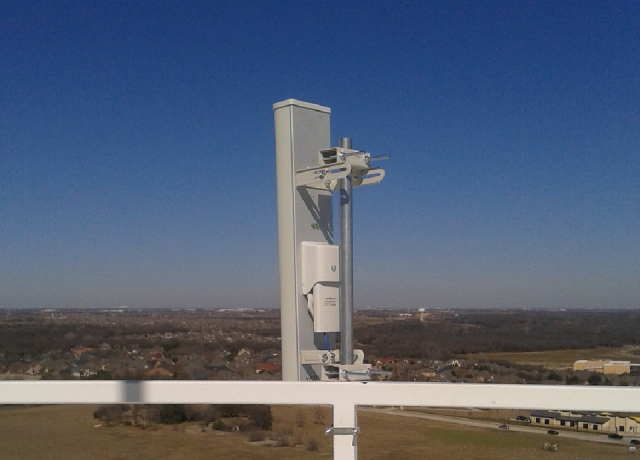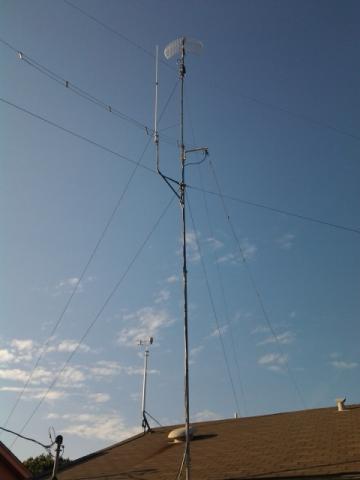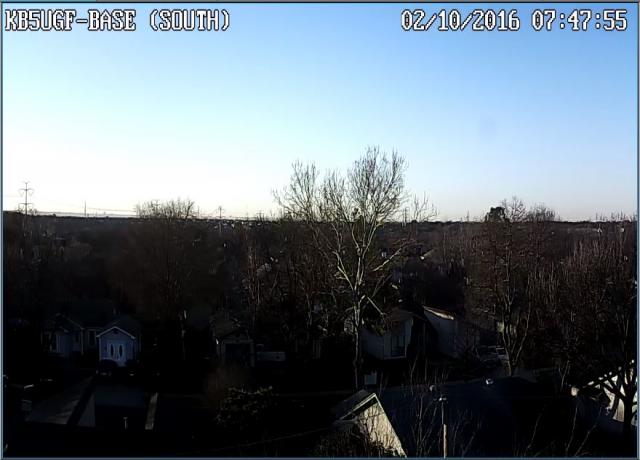The MJARS group in southeast Tarrant/northeast Johnson Counties has gone online with 4 nodes so far. The breakthrough came when a Rocket/sector was placed on a high perch in far southeast Tarrant County, covering a pretty fair piece of real estate. The link from that node to my node near Arlington Airport is 6 miles and I'm getting 27db s/n ratio and 100% LQ on channel -2. My node is a Bullet/24db dish at 42 ft. Another node near Joe Pool Lake is at the edge of the sector coverage and 4 miles away, as well as only being 14 ft up, but still getting about 17db s/n ratio and LQ often at 100%, dipping into the 80's at times. A 4th node has proven troublesome because of a hill and the omni antenna he is using, even though he is only 3 1/2 miles from the nearest node. Plans are to ditch that and try a Nano Station there, maybe a little higher up. There's at least 3 or more other club members that have a strong interest in putting up nodes. One is directly behind the sector at a distance of 7/10 of a mile but still gets a good signal I found out after researching his sight. Others are in decent paths at about 3 to 4 miles. We started out on channel 1 but abandoned that once the AREDN 3.15.1.0 went into general release. I had already been playing with it in beta. The noise floor on channel 1 was just too unbearable here, the MJARS node couldn't see me at all!
Services so far are all on my base node, kb5ugf-base. I started with HamChat. I connected directly with kb0dbj 2.5 miles away and we played with a duplex p2p video chat called FaceCom. I discovered I could insert a thumb drive into my cable modem and redirect to it from my node so I advertised that. Presto, super cheap file server and web page! And I put up a cheap $50 "weather camera" just below the mesh dish. I just set up a managed switch and the mesh has an Internet gateway through my node. My cable modem allows me to block/unblock http through the gateway to prevent content that's inappropriate under part 97 but still allow other protocols. Future plans are to roll out Winlink for the mesh, integrating it with the Internet and eventually VHF. Besides getting more nodes up, I'm hoping to get some more "computer guys" on board to help with ideas for apps, as well as implementing them on their nodes. The easier we can make if for the less computer-oriented types, the more likely we'll get more involvement. I envision our system providing a bullet-proof emcomm email system for our area that doesn't rely on the Internet, and a network of cameras that can monitor impending weather events, all coordinated with area public agencies to improve public safety.


You are here
SE Tarrant/NE Johnson Counties area mesh
Wed, 02/10/2016 - 00:36
#1
SE Tarrant/NE Johnson Counties area mesh
Theme by Danetsoft and Danang Probo Sayekti inspired by Maksimer



73, Mike
Update on MJARS mesh: Anticipating getting anther key central node installed next month for redundancy and new area coverage at a height of 120 feet. It will have a southern-facing weather camera. About that same time we'll put a weather camera up about 50 feet on an existing node in our NW area. We have a vlan tunnel and a marginal (at this point) rf link with about a dozen nodes in the Ellis County group to our SE. More weather cameras, IP phones. Working on smoothing out link anomalies with that group, possibly the result of their co-location on same channel (great lq, marginal nlq, high ping count). Our new previously mentioned node may also help that connection when it goes up. Also added a PBX server on a Raspberry Pi running Asterisk/FreePBX, but need to centrally locate for better performance, and eventually add a failover server elsewhere. Still have quality calls between all MJARS nodes with direct IP dialing. Still have plans for expansion to the SW to cover some more of our members and to aid in storm spotting with another camera or 2, since a lot of our weather comes from that direction. I put together a 'Go Node' for quick emergency deployment of mesh resources: Air Grid M2 for node, Bullet/omni for mesh-to-wifi link for multiple users, camera, 40 watt solar panel, 50 amp battery, IP phone. Works great!
OK, I've watched a couple YouTube videos about setting up the Ubiquiti NanoStation M2 nodes. I'm looking at the possibility of buying one but I want to make sure it will reach the closest MJARS mesh node, KF5YIV-NSM2-W. I live about a block or two east of Sycamore Airstrip in south Fort Worth. According to Google Maps I'm 12.06 miles away as the crow flies. I live in an HOA area so I can't put a mast up. I'm hoping I could put a node at the very top of my attic, say about 20' up from street level. Would that sort of configuration work or should I just wait and see if somebody else puts in a node closer?
Thanks in advance for any and all information and guidance.
Richard S.
KF5RHI
Hey David, can you say a little more about the picture above? I don't think you mentioned a pi on that so I'm assuming the core purposes is to extend the WAN coverage, correct? Would you mind being specific about the panel and controller and battery, etc? I'm just getting into this part. If you added a pi, operating with a 7" pi HDMI monitor which calls for 2 amp supply at the 5 volts how would that affect the solar/charge requirements, etc.?
Thanks and 73,
Patrick KM5L
This response should probably go under 'deployment' but since I'm also answering some specific questions you had I'll go ahead and post here. The purpose of this Go Node is to provide quick deployment of mesh resources in an event scenario. Resources include an IP camera, IP phone, and a multiple user wifi connection to the mesh, which may or may not include Internet. I don't have a Pi on this Go Node, although you could certainly use one, either through this system's wifi or a direct connect to the 5-port Ethernet switch in the battery box. That would make a good quick deployable PBX server! As for a portable monitor for a PI, I have a neat little 10 inch, 12 volt lcd tv/monitor with an hdmi jack in the shack that only draws 7 watts. But for the most part I just operate the Pi 'headless' and remote desktop into it from anywhere on the mesh with one of my laptops. The Go Node only extends WAN to the extent that the mesh this node is connected to has WAN, which our mesh does. THEN, you could (if you are a licensed ham and have the password) use this system's wifi to use the mesh's WAN connection. The Bullet M2, which is the wifi-mesh gateway, has been re-flashed with AirOS and set up as an access point. This allows password protection and utilization of AirOS's features like spectrum analysis and network monitoring (I like the 'kick' feature which allows you to disconnect unauthorized users!). The Go Node uses a 50-amp deep cycle battery like what is used for electric wheel chairs. The solar panel is a 40-watt poly-crystalline (many 4-inch mono-crystalline cells linked together and weather sealed) regulated by a 45-watt pwm (pulse width modulated) solar controller. This controller happens to be made by Battery Tender but any brand should do. I mounted the solar controller in a small aluminum project box and included a volt meter and ammeter to monitor things. I figure the load, with everything running, to be about 20 watts, so on a sunny day there should be plenty of juice to go around plus recharge the battery after a long night on the 'scene'. And with the 50-amp battery you could tolerate some clouds and still not run out of power. I have field tested this setup over last winter which included some short cloudy days. It can tolerate a couple of those before you have to give it a boost. I'll include a .tgz of the materials list and some particulars.
Many of us will be setting up this Saturday at "Point Node Park" in Richardson - you can google map to that name. Around 9 am. Would LOVE to have you join us and show your portable setup - also help us configure the correct power config - you would know!
Patrick KM5L 972 897 2726
Ron K7OPA
Ron -- I am the person who set up the PBX on the Mansfield mesh. It was relatively easy to do and you only need to know minimal Linux commands to do the install on the Pi. Do a search for Raspberry Pi and Asterisk and it will return a site that contains the whole image for the PBX and the steps on setup and configuration. Make sure you read all the documentation on the site and also look at the FreePBX documentation too. I believe it took a couple of hours to install and update everything to the latest versions.
Bart -- KF5BYG